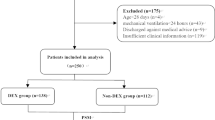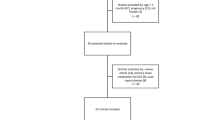Abstract
Objective
To describe main indications, doses, length of infusion and side effects related to dexmedetomidine infusion.
Methods
Observational and retrospective study evaluating dexmedetomidine use in pediatric intensive care unit.
Results
77 children received dexmedetomidine infusion longer than 6 hours for mechanical ventilation weaning (32.5%), post-neurosurgery and post-upper airway surgery (24.7%), non-invasive ventilation (13%), refractory tachycardia (6.5%) and other causes (23.3%). After 6 hours of infusion, significant decrease in mean arterial pressure and heart rate was observed in all groups. Six children (8%) required withdrawal of drug because of possible side effects: hypotension, bradycardia and somnolence.
Conclusion
Dexmedetomidine may be used as sedative in critically ill children without much side effects.
Similar content being viewed by others
References
Pichot C, Ghignone M, Quintin L. Dexmedetomidine and clonidine: from second-to first-line sedative agents in the critical care setting? J Intensive Care Med. 2012;27: 219–37.
Panzer O, Moitra V, Sladen RN. Pharmacology of sedative-analgesic agents: Dexmedetomidine, Remifentanil, Ketamine, volatile anesthetics, and the role of peripheral Mu antagonists. Crit Care Clin. 2009;25: 451–69.
Hsu CD, Cravero JP. Pharmacologic agents for pediatric procedural sedation outside of the operating room. UpTo Date. Available from: www.uptodate.com/online. Accessed July 6, 2014.
Reiter PD, Pietras M, Dobyns EL. Prolonged dexmedetomidine infusions in critically ill infants and children. Indian Pediatr. 2009;46:767–73.
Chrysostomou C, Schmitt CG. Dexmedetomedine: sedation, analgesia and beyond. Expert Opin Drug Metabo Toxicol. 2008;4:619–27.
Tobias JD. Dexmedetomidine: applications in pediatric critical care and pediatric anesthesiology. Pediatr Crit Care Med. 2007;8:115–31.
Burbano NH, Otero AV, Berry DE, Orr RA, Munoz RA. Discontinuation of prolonged infusions of dexmedetomidine in critically ill children with heart disease. Intensive Care Med. 2012;38:300–7.
Zhang X, Zhao X, Wang Y. Dexmedetomedine: a review of applications for cardiac surgery during perioperative period. J Anesth. 2015;29:102–11.
Chrysostomou C, Beerman L, Shiderly D, Berry D, Morell VO, Munoz R. Dexmedetomidine: A novel drug for the treatment of atrial and junctional tachyarrhythmias during the perioperative period for congenital cardiac surgery: a preliminary study. Anesth Analg. 2008;107:1514–22.
Whalen LD, Di Gennaro JL, Irby GA, Yanay O, Zimmerman JJ. Long-term Dexmedetomidine use and safety profile among critically ill children and neonate. Pediatr Crit Care Med. 2014;15:706–14.
Su F, Nicolson SC, Zuppa AF. A dose-response study of dexmedetomidine administered as the primary sedative in infants following open heart surgery. Pediatr Crit Care Med. 2013;14:499–507.
Walker J, Maccallum M, Fischer C, Kopcha R, Saylors R, McCall J. Sedation using dexmedetomidine in pediatric burn patients. J Burn Care Res. 2006;27:206–10.
Prasad SR, Simha PP, Jagadeesh AM. Comparative study between dexmedetomidine and fentanyl for sedation during mechanical ventilation in post-operative paediatric cardiac surgical patients. Indian J Anaesth. 2012;56:547–52.
Author information
Authors and Affiliations
Corresponding author
Rights and permissions
About this article
Cite this article
Andreolio, C., Piva, J.P., Baldasso, E. et al. Prolonged infusion of dexmedetomidine in critically-ill children. Indian Pediatr 53, 987–989 (2016). https://doi.org/10.1007/s13312-016-0973-2
Received:
Revised:
Accepted:
Published:
Issue Date:
DOI: https://doi.org/10.1007/s13312-016-0973-2




